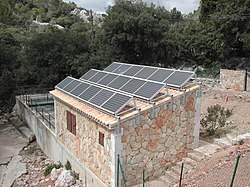Environmentally friendly (also eco-friendly, nature friendly, and green) are synonyms used to refer to goods and services, laws, guidelines and policies considered to inflict minimal or no harm on the environment.[1] To make consumers aware, environmentally friendly goods and services often are marked with eco-labels. But because there is no single international standard for this concept, the International Organization for Standardization considers such labels too vague to be meaningful.[2]
Regional variants[]
Europe[]

A sewage treatment plant that uses environmentally friendly solar energy, located at Santuari de Lluc monastery.
Products located in members of the European Union can use the EU's Eco-label pending the EU's approval.[3] EMAS is another EU label[4] that signifies whether an organization management is green as opposed to the product.[5] Germany also uses the Blue Angel, based on Germany's standards.[6]
North America[]
In the United States, environmental marketing claims require caution. Ambiguous titles such as environmentally friendly can be confusing without a specific definition; some regulators are providing guidance.[7]
The United States Environmental Protection Agency has deemed this language useless in determining whether a product is truly "green".[2]
In Canada, one label is that of the Environmental Choice Program.[6] Created in 1988,[8] only products approved by the program are allowed to display the label.[9]
Oceania[]
The Energy Rating Label is a Type III label[10][11] that provides information on "energy service per unit of energy consumption".[12] It was first created in 1986, but negotiations led to a redesign in 2000.[13]
International[]
Energy Star is a program with a primary goal of reducing greenhouse gas emissions.[14] Energy Star has different sections for different nations or areas, including the United States,[15] the European Union [16] and Australia.[17] The program, which was founded in the United States, also exists in Canada, Japan, New Zealand, and Taiwan.[18]
See also[]
- Design for Environment
- Environmental Choice Program
- Environmental enterprise
- Environmentalism
- Environmental movement
- Environmental organizations
- Environmental protection
- Green brands
- Greener festivals
- List of environmental issues
- List of environmental organizations
- List of environmental topics
- Natural capital
- Natural environment
- Natural resource
- Nature
Template:Br
References[]
- ↑ "nature-friendly". Webster's New Millennium Dictionary of English, Preview Edition (v 0.9.7). Lexico Publishing Group, LLC..
- ↑ 2.0 2.1 "Labels -environmentally friendly". ecolabels. http://www.greenerchoices.org/eco-labels/eco-home.cfm?redirect=1. Retrieved 2007-07-09.
- ↑ "Welcome to the European Union Eco-label Homepage". EUROPA. http://ec.europa.eu/environment/ecolabel/index_en.htm. Retrieved 2007-07-10.
- ↑ "EMAS". EUROPA. http://ec.europa.eu/environment/emas/index_en.htm. Retrieved 2007-07-10.
- ↑ "Minutes" (PDF). EUEB Coordination and Cooperation Management Group. http://ec.europa.eu/environment/ecolabel/pdf/meetings/draftmin0905.pdf. Retrieved 2007-07-10.
- ↑ 6.0 6.1 "Environmental Labels Type I". Ricoh. http://www.ricoh.com/environment/label/type1/index.html#hun_eco. Retrieved 2007-07-10.
- ↑ "Environmental Claims". Federal Trade Commission. 2008-11-17. http://www.ftc.gov/bcp/grnrule/guides980427.htm. Retrieved 17 November 2008.
- ↑ "About the Program". EcoLogo. http://www.environmentalchoice.com/English/ECP%20Footer/About%20the%20Program. Retrieved 2007-07-10.
- ↑ "Environmental Choice (Canada)". Environment Canada. http://www.ns.ec.gc.ca/g7/eco-can.html. Retrieved 2007-07-10.
- ↑ "Overview of Regulatory Requirements - Labelling and MEPS". Energy Rating Label. http://www.energyrating.gov.au/man1.html. Retrieved 2007-07-10.
- ↑ Arnaud Bizard, Brett Lee, Karen Puterrman (PDF). AWARE and Environmental Labeling Programs: One Step Closer to a Sustainable Economy. ME 589. http://www.cmu.edu/me/ddl/AWARE/AWARE-Labeling-Report-ME589-2004.pdf. Retrieved 2007-07-10.
- ↑ "Overview of how are star ratings calculated?". Energy Rating Label. http://www.energyrating.gov.au/star.html. Retrieved 2007-07-10.
- ↑ "The Energy Label". Energy Rating Label. http://www.energyrating.gov.au/con3.html. Retrieved 2007-07-10.
- ↑ "About Energy Star". Energy Star. http://www.energystar.gov/index.cfm?c=about.ab_index. Retrieved 2007-07-10.
- ↑ "United States Energy Star Home Page". Energy Star. http://www.energystar.gov/. Retrieved 2007-07-10.
- ↑ "EU Energy Star Home Page". Energy Star. http://www.eu-energystar.org/. Retrieved 2007-07-10.
- ↑ "Australia Energy Star Home Page". Energy Star. http://www.energystar.gov.au/. Retrieved 2007-07-10.
- ↑ "Who’s Working With ENERGY STAR? International Partners". Energy Star. http://www.energystar.gov/index.cfm?c=partners.intl_implementation. Retrieved 2009-02-03.
External links[]
- Hugsmovement Eco Lifestyle
- No Impact Guidance on sustainable modern living
- Global Action Plan Environmental Overview A quick intro to environmental issues